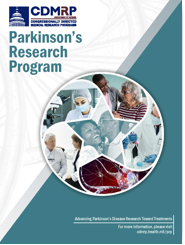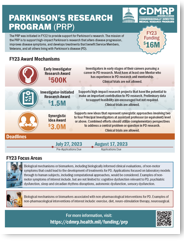Parkinson's
Vision – Improve the health and lives of people with Parkinson's disease through innovative,
Parkinson's disease (PD) is a degenerative movement disorder of the central nervous system resulting from a loss of neurons in a region of the brain called the substantia nigra. These neurons produce dopamine, a neurotransmitter important for motor control; however, as PD progresses, the death of dopaminergic neurons results in reduced dopamine levels and impairment of motor control.
For FY22, Congress transitioned the Neurotoxin Exposure Treatment Parkinson's (NETP) program to the Parkinson's Research Program (PRP) and broadened the research from neurotoxin exposure treatment PD research to all types of PD research. The PRP challenges the scientific community to develop the most impactful research that will advance the understanding of the disease, with the ultimate goal of ending PD.
For information on toxic exposure research, please go to the Toxic Exposures Research Program at CDMRP.
![]()
Congressional Appropriations
- $32 million
FY22-23 - $16 million
FY24

Funding
Summary
- 32 Awards in FY22-23
- Recent Applications Recommended for Funding

Programmatic
Panels

Peer Review Participants
Related Videos
Dr. Angus Nairn Video
Yale University School of Medicine
Proteomic Methods for Analyzing Protein
Dr. Andrew Singleton Video
National Institute on Aging
Whole-Genome Sequencing
in Parkinson's Disease
Dr. Kenneth Marek Video
Institute for Neurodegenerative Disorders
Evaluating the Natural History of Prodromal PD
Dr. Caroline Tanner
University of California, San Francisco
Persistent Organic Pollutants and Parkinson's disease in Native Populations of Hawaii and Alaska
Dr. Paul Greengard
Rockefeller University
New P11 Biomarker Predicts Clinical Effectiveness of Antidepressant Drugs
Dr. Howard J. Federoff
University of California, Irvine
PGC-1α Therapy for
Parkinson Neurodegeneration
Last updated Monday, March 17, 2025
















